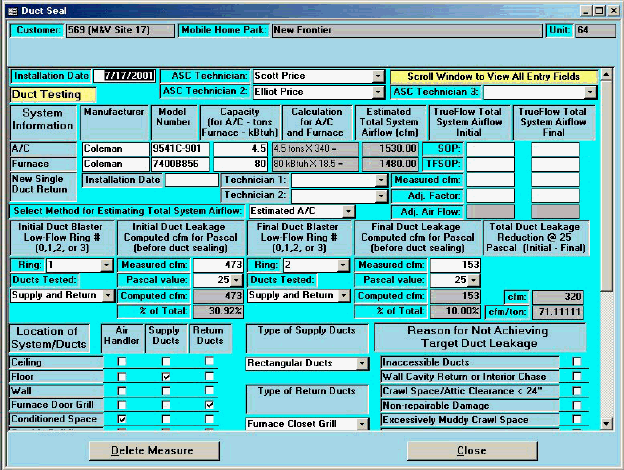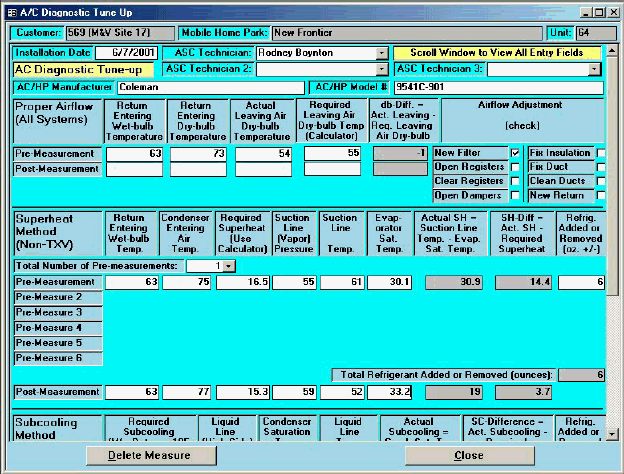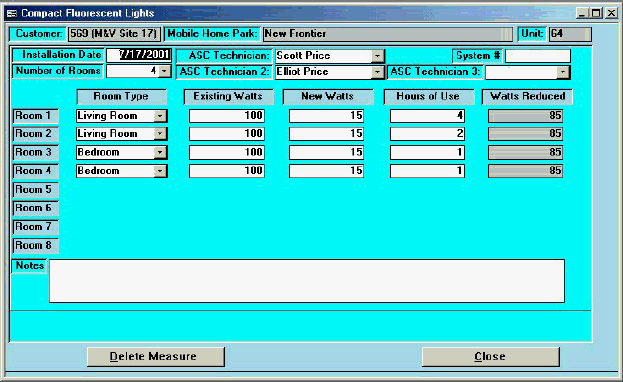OF THE STATE OF CALIFORNIA
Order Instituting Rulemaking to Examine the Commission's Future Energy Efficiency Policies, Administration and Programs. |
R.01-08-028 (Filed August 23, 2001) |
American Synergy Corporation with Robert Mowris and Associates respectfully submit the following information in response to questions received March 13, 2002 about the "Comprehensive Hard-to-Reach Mobile Home Energy Savings Program" in the Pacific Gas & Electric (PG&E) service territory.
18 March 2002
Mr. Tuukka Hess
Energy Division
State of California
Public Utilities Commission
505 Van Ness Avenue
San Francisco, CA 94102-3296
Dear Tuukka:
We appreciate your letter seeking additional information on our proposal entitled "Comprehensive Hard-to-Reach Mobile Home Energy Savings Program." I have itemized each item that you have requested clarification or more information with a number and the request for information, with our response in Italics.
1. The program claims to "provide a comprehensive energy program to 4000 small commercial customers." (pg. 6 of proposal) Nowhere are plans for this small commercial program mentioned. Do you plan on offering services to this sector? If so, please provide appropriate details.
On the original and hard copies of the proposal this item was supposed to have been crossed-out and initialed. One may have slipped through where it was not crossed off. If it still appears in the proposal, this is in error and should be deleted. I went back and noticed in the electronic filing that it is already deleted.
2. What measures will be provided to the typical mobile home? Please include the number of units installed on a per-measure basis. (e.g. X # compact fluorescent light bulbs.)
Typical measures that will be installed include a combination of the following items:
We anticipate that the mobile home customers that we target will require many of these measures since few contractors specialize in servicing mobile homes and there is a great need for serving these customers and homes (one of the most underserved and hard-to-reach markets).
The mobile home property manager or owner will be contacted about the availability of this comprehensive hard-to-reach energy savings program. With permission of the park manager, each mobile home customer will receive a letter informing him or her of the program. The mobile home owner will call our office for a scheduled appointment. We do not "cold" call customers directly - they call us.
At the appointed time, the trained technician will do a survey of the mobile home to see what energy efficient measures that it stands in need of. Once an assessment is completed, the technician and work crew will perform whatever measures are needed to fully maximize energy savings and satisfaction for the customer. Pre- and post-test results are provided to the customer to indicate the improvement of their system.
It is our estimate that 6,000 mobile home owners will require some type of energy efficiency measure to maximize their energy efficiency, as projected above. Some homes will already have certain measures installed. Because most of the measures have a long-term permanence, we will install what is needed.
3. Will the services provided to mobile home residents include the conduction of Combustion Appliance Safety testing? If so, please provide the budget details associated with this work, on a per-test basis.
If the Commission requires the use of CAS testing for all affected energy efficiency programs, then ASC and RMA will incorporate such testing into our programs. Such a requirements, should they be required at all, should be implemented in a uniform state-wide procedure for all IOUs and all costs for the testing should come solely from IOU funds outside of PGC funds.
This is the procedure already approved by the Commission in the Commission's LIEE dockets for similar requirements. It is our understanding that PG&E does not include this requirement for its own upcoming (2002) Residential or Multi-Family rebate and retrofit programs. Nor do any of the other IOUs include this testing for their Statewide or Local programs involving combustion appliances or other measures affecting combustion appliance safety.
While the IOU residential and multi-family rebate programs are not as comprehensive and do not include, for example, duct testing and sealing work or AC Diagnostics, they do include infiltration reducing measures such as window repair and replacement and attic insulation packages which usually include infiltration reduction features.
The issue of CAS tests being required when retrofits may reduce infiltration rate has been extensively reviewed in a number of dockets, especially in the low-income dockets. In these, the Commission has not required CAS tests be mandated. To date the Commission has left it up to the utilities to determine under what circumstances to require CAS tests and when (before or after installation).
The Commission does have an open docket item to determine the need for such tests and, if needed, how to standardize their use. However, in ALL related decisions, the Commission has required that if PG&E or any other IOU does require any CAS tests, these be paid for by the IOUs, which have been budgeted funds for these, and that the costs NOT be charged to PGC funds. For this reason, we have not included these as a measure or as a cost. The Commission does not require the use of CAS tests to date. And if they do become required, then we expect that the cost of these will be charged to the utilities' general funds and not to the PGC funds. If CAS testing is to be required at all, the utilities should use a uniform state-wide procedure for all CAS testing required and that any costs for the testing shall come solely from IOU funds outside of PGC funds. This is the procedure already approved by the Commission in the Commission's LIEE dockets.
ASC has performed many thousands of duct tests and seals on mobile homes in the Southern California Edison and Southern California Gas areas, without the requirement of a CAS test. We also completed a 3rd party initiative with San Diego Gas & Electric with over 1,000 mobile homes, and once again, there was no requirement of a CAS test.
However, if a CAS test is required, the cost to perform this work takes approximately 30-45 minutes and the per-test cost would be $50.00 per site. If the customer does not pass the CAS test, both the customer and utility will be informed for corrective action. Corrective action would be the responsibility of the customer.
If, indeed, the CPUC requires a CAS test for each mobile home to be paid for from our budget, then ASC will need to modify or reduce the total number of proposed mobile homes served to accommodate this added service.
4. Does the program intend to include safeguards to ensure that, on the whole, a comprehensive package of energy efficiency measures will be delivered to mobile home residents? If so, please provide details of these safeguards.
Our installers and auditors are trained to evaluate each potential mobile home participant to determine the most complete set of comprehensive measures to install. All technicians are thoroughly trained on duct testing and sealing and air conditioner tune-ups.8 A thorough audit of each mobile home is performed to see if the measures mentioned above are installed. Measures are noted on data collection/installation forms or entered electronically into our Microsoft Access Mobile Home Database. Technicians report their pre-test and post-test information in order to verify proper installation (a sample of our Mobile Homes database data collection screens are shown in Attachment 1). These data collection forms will be modified specifically for this proposal.
During the year of 2001, American Synergy Corporation successfully completed a number of Mobile Home Projects and also participated in the Summer Initiative Program. During those programs American Synergy Corporation and Robert Mowris and Associates established a track record of installing a variety of measures that worked toward realizing a comprehensive package view versus installation of one or two measures. In one of the projects, a 3rd party initiative, designed to improve the energy efficiency of mobile homes, ASC and RMA completed Duct Test/Seals, AC Diagnostic Tune-ups, CFL installations on 95% of homes and installed Programmable Thermostats on 13% of homes. During the SIP program ASC completed 51% duct seals, 35% water heater blankets, 26% weather stripping, 65% CFL installations, 39% Low-Flow Showerheads, and 24% aerators.
One of the key parts of this proposal is the strong accountability component established by the ME&V services provided by Robert Mowris and Associates. ASC and RMA are independent companies to one another. Robert Mowris and Associates have a solid reputation as energy efficiency engineer and have worked with ASC to safeguard that a comprehensive package of energy efficiency measures are installed. We will account for the production.
One important additional item is that American Synergy has been a reputable energy efficiency contractor for over 20 years in California. It has a history of completing its benchmarks as outlined. ASC and RMA hope to still be making a contribution 20 years from now. That will only be possible as ASC and RMA completes the work as outlined.
American Synergy's Mission Statement is "We Treat People Right". That applies to customers, employees and the individuals or organizations that we contract to do work for.
We believe that the most significant safeguards are our track record, and the independent accountability set up within the program of ME&V.
5. Does the program intend to include safeguards to ensure that contractors do not use public purpose funds to promote services not included under this program? (i.e. Contractor promotes own services to residents when conducting program work.) If so, please provide details of these safeguards.
This program intends to safeguard the use of public purpose funds by installing the work that is outlined in our proposal. We will not offer "other" services unless it is absolutely necessary. For example, if a customer has a non-functional duct system or air conditioner system and desires a functional system, then we will offer to install a functional system at the most reasonable cost possible and take advantage of incentives where appropriate from other statewide programs (i.e., incentives for SEER 12 or better ac units under the 1-2-3 Cash Back Program). This will allow our program to complement existing programs wherever possible without promoting our own self-interest.
Our goals are to maximize energy savings and customer satisfaction by providing an innovative comprehensive energy efficiency program to hard-to-reach mobile home customers. One of the most significant safeguards will be the accountability that American Synergy will provide that accounts for the work done for each customer.
Conclusion:
American Synergy Corporation along with Robert Mowris and Associates appreciate the opportunity to respond to Tuukka Hess' request for clarification. We are excited about the possibilities of working in conjunction with the Commission and Utility to provide these much needed services to a group of ratepayers and customers that are clearly hard-to-reach and underserved because of their economic status, living facilities, and unique demographics. We wish to assure the commission that ASC and RMA will do everything in their power to complete this project in a way that will make us all proud and in a way that will leave a lasting impact in energy conservation and savings.
Sincerely yours,
_____________________
Steven R. Shallenberger, President ASC
Email: Shallenbgr@aol.com
For and in behalf of:
Kathleen E. Carlson, President RMA
Email: rmowris@earthlink.net
Attachment 1. Mobile Home Database Data Collection Screens

Figure 1. Duct Testing and Sealing Data Collection Screen (Computed cfm and cfm/ton leakage reduction are computed and checked to ensure quality control).

Figure 2. AC Diagnostic Tune-up Data Collection Screen (Superheat and subcooling values and refrigerant properties are checked when data is entered to ensure quality control).

Figure 3. CFL Data Collection Screen (Watts reduced are calculated in database to ensure quality control).
Attached please find SDG&E's response to your request for information on the Local Nonresidential Retrofit EZ Turnkey proposal. If you have any questions or require additional information, please do not hesitate to contact me.
<<Document.pdf>> <<SDGE Response to ED DR 3_11 re EZTurnkey.xls>>
J. C. Yamagata
Sempra Energy
Regulatory Affairs
Phone: 858-654-1755
Fax: 858-654-1788
Email:
jyamagata@sempra.com
The Energy Coalition
1540 South Coast Highway, Suite 204, Laguna Beach, CA 92651 (949) 497-5110 fax (949) 497-6406
STATE OF CALIFORNIA GRAY DAVIS, Governor

PUBLIC UTILITIES COMMISSION
505 VAN NESS AVENUE
SAN FRANCISCO, CA 94102-3298
March 13, 2002



